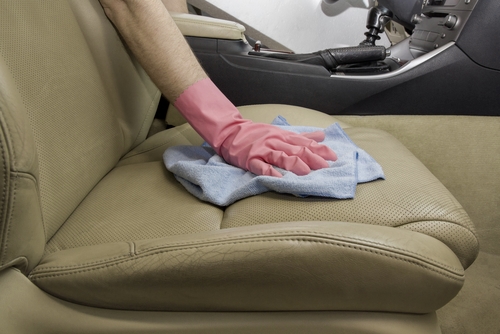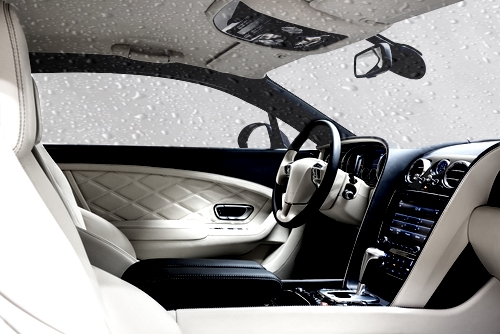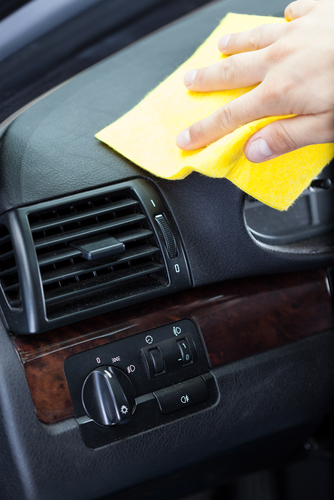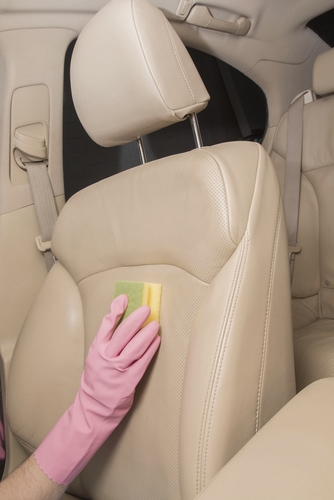Persistent damp in the car is more than a mere nuisance. If it smells musty, the windows are constantly fogged up on the inside and the mats are soaked, this can be a serious warning sign. This guide will help you easily remove damp from your car.
Extra condensation and damp in the car interior
 Interior dampness can be smelled, felt and seen. In normal use of the car the musty smell is the first sign. If it does not disappear after a thorough interior cleaning you need to have a closer look. Interior dampness can be smelled, felt and seen. In normal use of the car the musty smell is the first sign. If it does not disappear after a thorough interior cleaning you need to have a closer look. |
 A typical spot for moisture to collect is the foot area. To check this, firmly press a kitchen cloth on the carpet. Possible moisture being absorbed by the cloth can be identified quickly and unmistakeably. A typical spot for moisture to collect is the foot area. To check this, firmly press a kitchen cloth on the carpet. Possible moisture being absorbed by the cloth can be identified quickly and unmistakeably. |
Further symptoms are: fogged up and sometimes even iced interior windows, mould in the interior, damp seats.
What causes damp in the car interior?
Damp can happen with regular use. Snow remaining on the shoes is the most common cause of damp in the car interior. This should pose no problem and becomes apparent during driving. The air conditioning of the car is an adequate de-humidifier and can be used to this end in winter as well. However, if there is a consistent damp problem in the car, this deserves extra attention.
A damp interior can develop in many ways. They all have in common that unwanted water enters the car. Water in a car is not necessarily just water. Therefore, the first measure is to determine where the moisture penetrates. Water can reach the interior in three ways:
1. Rainwater: The cause of penetrating rain water is often a leaking sun roof. A typical sign is a damp seat. Water might drip on the driver’s head during driving. Not only is this a nuisance, but can lead to dangerous traffic situations. Another cause of penetrating rain water is leaking windows. This would indicate that they are seriously corroded. Depending on car type a clogged drainage can be the cause of penetrating water. The first model series of Fiat Panda and VW Golf 5 had this problem. The piping meant for draining splashed rain water could become clogged by foliage and mud. The problem was solved by flushing out the drainage pipes. We recommend checking the car for this possibility. The cause of penetrating rain water is often a leaking sun roof. A typical sign is a damp seat. Water might drip on the driver’s head during driving. Not only is this a nuisance, but can lead to dangerous traffic situations. Another cause of penetrating rain water is leaking windows. This would indicate that they are seriously corroded. Depending on car type a clogged drainage can be the cause of penetrating water. The first model series of Fiat Panda and VW Golf 5 had this problem. The piping meant for draining splashed rain water could become clogged by foliage and mud. The problem was solved by flushing out the drainage pipes. We recommend checking the car for this possibility. |
2. Water splashing against the base of the car: If water splashing against the bottom of the car penetrates the base plate, the solution can be easy: every base plate has a drain under its carpet. This is a mounted piece of rubber, built in for construction purposes. The excess paint flows out of the bodywork by way of this rubber after passing the paint shop in the construction facility. This rubber drain can over time become brittle, fall out or sustain damage through grit. Holes in the drain can be sealed with silicone kit. Welding the drainage shut is not recommended, as the drainage might be useful in emergency situations. Much more problematic is the splashing water penetrating through a corrosion hole. In this case, the car is no longer suitable for road traffic and must be repaired as soon as possible. A corrosion hole in the base plate is very often only one of many. If water splashing against the bottom of the car penetrates the base plate, the solution can be easy: every base plate has a drain under its carpet. This is a mounted piece of rubber, built in for construction purposes. The excess paint flows out of the bodywork by way of this rubber after passing the paint shop in the construction facility. This rubber drain can over time become brittle, fall out or sustain damage through grit. Holes in the drain can be sealed with silicone kit. Welding the drainage shut is not recommended, as the drainage might be useful in emergency situations. Much more problematic is the splashing water penetrating through a corrosion hole. In this case, the car is no longer suitable for road traffic and must be repaired as soon as possible. A corrosion hole in the base plate is very often only one of many. |
3. Water from the interior heating A damp car floor can also indicate a leakage of the interior heating. With a simple test, damage of the heat exchanger can be tested. First check the level of the coolant. The heat exchanger for the heating system is connected to the cooling cycle. If there is a defect, the engine loses coolant, which is very important for safe use of the car. A damp car floor can also indicate a leakage of the interior heating. With a simple test, damage of the heat exchanger can be tested. First check the level of the coolant. The heat exchanger for the heating system is connected to the cooling cycle. If there is a defect, the engine loses coolant, which is very important for safe use of the car. |
Switch on the heating and put the interior blower on windshield ventilation. If it condensates right at the nozzle, the heat exchanger is probably defective. If the car floor is already wet, take a white moist-absorbing cloth. Toilet paper, kitchen paper or paper handkerchiefs are most suitable for this. Absorb a bit of moisture in the cloth or paper and check its colour. If it is clear, it is probably splashing water from below the car. If it is the coolant’s colour, you have found the cause.
 Tip: a heat exchanger is a very cheap spare part. Depending on car it costs between £13 and £45. Its installation is rather complicated. In most cases, the entire dashboard with steering wheel and airbag must be disassembled. Technically it is not too difficult; however a layman may want to plan an entire weekend for this.
Tip: a heat exchanger is a very cheap spare part. Depending on car it costs between £13 and £45. Its installation is rather complicated. In most cases, the entire dashboard with steering wheel and airbag must be disassembled. Technically it is not too difficult; however a layman may want to plan an entire weekend for this.
 Removing damp from your car
Removing damp from your car
If you have determined the cause, your car is now protected against further penetration of unwanted water. Now you need to remove the present moisture to make the car fully comfortable again.
Work thoroughly to prevent smell and mould to settle in the interior.
How to get rid of damp in the car |
|
1. Checking the textile
|
|
2. Removing extra damp from your car
|
 The remaining damp in the car can be removed with help of a desiccant; those with silica gel are very suitable. In a three-piece set these cost £11 – £13. If you prefer a cheaper method, use salt or charcoal. Take an empty biscuit tin and perforate its lid with a spike tool. The more holes, the better it works. Fill the tin with charcoal. Please ensure that you only use pieces which are bigger than the holes. Tape the tin shut with tape and put it under the passenger seat. The dry charcoal will now gradually absorb all moisture from the interior. Instead of charcoal and a tin, you can try old socks filled with salt or cat litter.
The remaining damp in the car can be removed with help of a desiccant; those with silica gel are very suitable. In a three-piece set these cost £11 – £13. If you prefer a cheaper method, use salt or charcoal. Take an empty biscuit tin and perforate its lid with a spike tool. The more holes, the better it works. Fill the tin with charcoal. Please ensure that you only use pieces which are bigger than the holes. Tape the tin shut with tape and put it under the passenger seat. The dry charcoal will now gradually absorb all moisture from the interior. Instead of charcoal and a tin, you can try old socks filled with salt or cat litter.
 Tips for quick readers:
Tips for quick readers:
– Put newspapers on the foot space in autumn and winter
– Make your own interior dryers with charcoal, cat litter or salt
– Immediately repair a defective heat exchanger
– Check drainage pipes on clogging
– Replace rotting foot mats or carpet
Foto: nikhg, 290712, FotoDuets, Kzenon, FotoDuets, Photographee.eu, photosthai, Alexey Ryazanov, Monika Wisniewska/ shutterstock.com






 (15 votes, average: 3.60 out of 5)
(15 votes, average: 3.60 out of 5)







